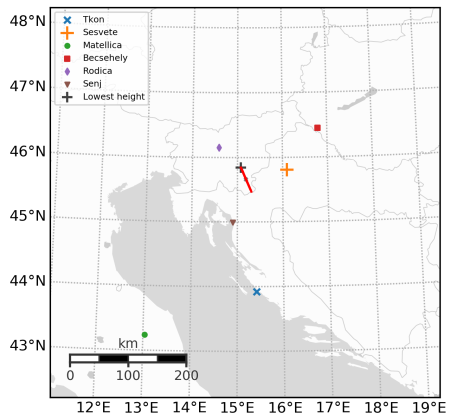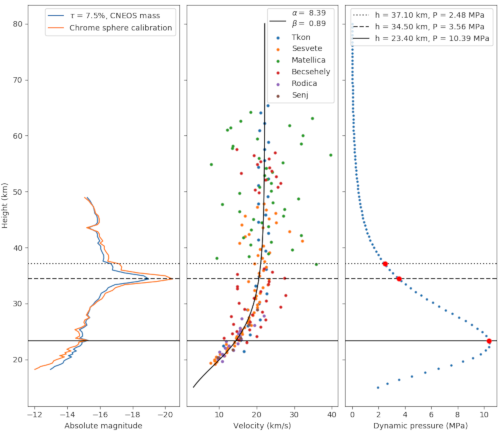Novo Mesto meteorite fall – trajectory, orbit, and fragmentation analysis from optical observations
- 1Department of Physics and Astronomy, University of Western Ontario, London, Ontario, N6A 3K7, Canada (dvida@uwo.ca)
- 2Astronomical Society "Istra" Pula, HR-52100 Pula, Croatia
- 3Pula Gymnasium, HR-52100 Pula, Croatia
- 4Astronomical Institute, Czech Academy of Sciences, Fričova 298, CZ-25165 Ondřejov, Czech Republic
- 5Astronomical Institute, Charles University, Prague, V Holešovičkach 2, CZ-18000 Prague 8, Czech Republic
- 6Geological Survey of Slovenia, Dimičeva 14, SI-1000 Ljubljana, Slovenia
- 7Center of Excellence on Nanoscience and Nanotechnology – Nanocenter (CENN Nanocenter), Jamova 39, SI-1000 Ljubljana, Slovenia
- 8Natural History Museum Vienna, Burgring 7, A-1010 Vienna, Austria
- 9MBK Team, Orion Astronomical Society, SI-2000 Maribor, Slovenia
- 10Faculty of Mathematics and Physics, University of Ljubljana, Jadranska 19, SI-1000 Ljubljana, Slovenia
- 11CNR-IOM Laboratorio Nazionale TASC, Basovizza SS-14, km 163.5, IT-34012 Trieste, Italy
- 12Slovenian Environment Agency, Vojkova 1b, SI-1000 Ljubljana, Slovenia
- 13Istrastream d.o.o., Stanica Roč 1/1, HR-52425 Roč, Croatia
- 14Astronomical society Anonymus, Brace Radić 34, HR-31550 Valpovo, Croatia
- 15Hvar Observatory, Faculty of Geodesy, University of Zagreb, Kačićeva 26, HR-10000 Zagreb, Croatia
- 16Department of Physics, University of Rijeka, HR-51000 Rijeka, Croatia
- 17Academical Astronomical Society - Rijeka, HR-51000 Rijeka, Croatia
- 18Amateur Astronomical Association Nagykanizsa, HU-8800 Nagykanizsa, Hungary
- 19Department of Physics, University of Camerino, IT-62032 Camerino (MC), Italy
- 20High School Jelkovec, HR-10360 Sesvete, Zagreb, Croatia
On February 28, 2020 at 09:30:32 UTC, a daytime superbolide was observed over southeastern Slovenia and neighbouring countries1. In the following days, three meteorite pieces (469, 203, and 48 grams)2 were recovered nearby the Slovenian city of Novo Mesto by local people. The meteorite was classified as an L5 ordinary chondrite, more or less brecciated and shocked.
In this work we reconstruct the trajectory using the available video data which consist of two static security cameras and four dash cameras mounted on cars in motion (Figure 1). We use a new radial distortion method developed by Vida et al. (2021) to accurately model the lens distortion of individual cameras and we determine the position of the vehicles to a precision of several centimetres on every video frame.

Figure 1. Map of observer locations and the fireball trajectory (red line).
The preliminary trajectory was computed using the lines of sight method and the trajectory uncertainties were computed using the Monte Carlo method (Vida et al., 2020) by adding 3σ noise to the original measurements. The fireball was first observed at a height of 68.7 km and it reached an end height of 17.1 km. The fireball had an entry angle of 47.812° ± 0.096° and an initial velocity of 22.098 ± 0.012 km/s (computed using measurements above 45 km, i.e. before any noticeable deceleration was visible). Figure 2 shows that the average per-station trajectory spatial fit errors were around 100 m (200 m maximum). More observations will be included in a future analysis.
Figure 2. Spatial trajectory fit residuals. The Tkon and Senj stations were fixed security cameras, but only Tkon was calibrated on stars.
The fireball had the following geocentric radiant (J2000):
| R.A. |
330.920 ± 0.095 deg |
| Dec |
+2.320 ± 0.098 deg |
| VG |
18.991 ± 0.014 km/s |
| LG |
333.802 ± 0.093 deg |
| BG |
+13.319 ± 0.103 deg |
The computed orbit is:
| La Sun |
338.983613 deg |
| q |
0.5679 ± 0.0011 AU |
| a |
1.451 ± 0.004 AU |
| e |
0.60866 ± 0.0006 |
| i |
8.755 ± 0.063 deg |
| peri |
82.649 ± 0.184 deg |
| node |
338.993041 deg |
| T |
1.7473 ± 0.0072 years |
| TJ |
4.4156 ± 0.0091 |
A parent body search returned a match for a few objects, depending on the used D criterion. The Potentially Hazardous Asteroid 2005 OX had the Southworth & Hawkins (1963) DSH criterion value of 0.078, while the Drummond (1981) criterion had close matched for asteroids 2008 DK5 (DD = 0.043), 2004 DF2 (DD = 0.050), and also 2005 OX (DD = 0.058). Possible connection to these objects may be a topic of future work, although these correlations might be spurious as the orbital parameter space is dense in that region.
The fireball was bright enough to be picked up by the US government sensors3 which measured a total radiated energy of 11.5×1010 J. Assuming a typical L chondrite bulk density of 3620 kg/m3, we estimate that the meteoroid had an initial mass of 470 kg, corresponding to a diameter of about 0.63 m. We use the energy estimate to scale the observed light curve using the luminous efficiency of Borovička et al. (2020) – it compares well to an empirically derived light curve using a light source of known magnitude (reflection of the Sun from a chromium sphere at various distances). The fireball had one major fragmentation event at the height of 35 km which was picked up by the seismographs in the vicinity.
A total of 18 fragments were tracked on the videos after the main fragmentation. The dynamic mass analysis shows that the final mass of the largest fragment was on the order of 10 kg. This rather large fragment has not been found yet – it is possibly buried into the soft ground and ploughed over. The fireball experienced fragmentations at dynamic pressures of 2.5, 3.5, and 10 Mpa, as shown in Figure 3. The peak dynamic pressure is the highest ever measured, after the the Benešov fall (Borovička et al., 1998).

Figure 3. Left: Light curve measured on the Sesvete dash cam video. Blue curve is scaled using the CNEOS energy, and the orange curve was derived using the chromium sphere and the original dash camera. Middle: Velocity measurements and the Gritsevich (2007) model fit. Right: Dynamic pressures derived using the velocity fit and the NRL-MSISE00 air density model (Picone et al., 2002). Observed fragmentation points are marked with horizontal lines.
The distribution of finds on the ground indicate that these meteorites were not produced at the end height but that some were ejected at several discrete heights above 20 km.
Footnotes:
1AMS fireball report: https://fireball.imo.net/members/imo_view/event/2020/1027
2Meteoritical Bulletin Database, entry for Novo Mesto: https://www.lpi.usra.edu/meteor/metbull.php?code=72430
3CNEOS Fireballs: https://cneos.jpl.nasa.gov/fireballs/
References:
Borovička et al. (1998). A&A, 334, 713-728.
Borovička et al. (2020). AJ, 160(1), 42.
Drummond, J. D. (1981). Icarus, 45(3), 545-553.
Gritsevich, M. I. (2007). Solar System Research, 41(6), 509-514.
Picone et al. (2002). Journal of Geophysical Research: Space Physics, 107(A12), SIA-15.
Southworth, R. B., & Hawkins, G. S. (1963). Smithsonian Contributions to Astrophysics, 7, 261-285.
Vida et al. (2020). MNRAS, 491(2), 2688-2705.
Vida et al. (2021). The Global Meteor Network - Methodology and First Results. Submitted to MNRAS.
How to cite: Vida, D., Šegon, D., Šegon, M., Atanackov, J., Ambrožič, B., McFadden, L., Ferrière, L., Kac, J., Kladnik, G., Živčić, M., Merlak, A., Skokić, I., Pavletić, L., Vinčić, G., Ćiković, I., Perkó, Z., Ilari, M., Malarić, M., and Macuka, I.: Novo Mesto meteorite fall – trajectory, orbit, and fragmentation analysis from optical observations, European Planetary Science Congress 2021, online, 13–24 Sep 2021, EPSC2021-139, https://doi.org/10.5194/epsc2021-139, 2021.

